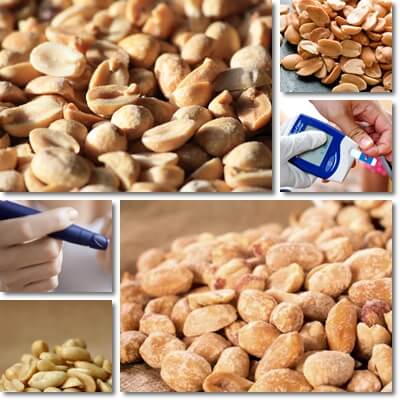Peanuts and diabetes make a good pair so long as intake is restricted to very small amounts of the likes of 1-2 oz/ounces a day or the equivalent of 28-56 g. Whether you’d benefit more from 1 or 2 ounce servings depends on your state of health, particularly current weight status, level of physical activity and other dietary choices. Ideally, diabetics should have no more than 1 serving of peanuts a day, preferably not every day, ideally – infrequently. One small serving is enough to satisfy cravings without providing excessive amounts of fat as well as allows for variation in one’s diet.
What types of peanuts are good for diabetics?
Raw, unprocessed, unsalted, unsweetened peanuts are the best choice for a diabetic. If you have diabetes, you are better off avoiding added sugars, salt and oil in your food. Added sugars raise your blood sugar levels, salt causes high blood pressure, water retention and puffiness and swelling, while excess fats undermine weight loss efforts. If you are already dealing with these health issues from your diabetes, choosing raw, unsalted, unsweetened peanuts is imperative to not making them worse.

As a diabetic, you get enough sugar from the carbohydrates in the fruits and vegetables in your daily diet. Even if it says ‘sweetened with honey’ on the label, remember honey is still sugar, albeit a natural form, and will add to your daily carbohydrate intake. Also, foods naturally contain sodium, including peanuts, so chances are you are getting enough from what you eat in a day – in any case, you don’t need as much as it’s added to salted nuts, especially if you are already dealing with diabetes-related hypertension. Lastly, considering peanuts are naturally rich in fat, plenty of which is healthy, you don’t need any more of it.
Do peanuts raise blood sugar?
Technically, eating peanuts only slightly raises blood sugar, but their overall effects on blood sugar are minimal. In fact, given their particular macronutrient profile, they actually help control blood sugar in diabetics. Peanuts have an average of 16-17 g of carbohydrates per 100 g (of which 8.5 to 9.5 g are made up of indigestible dietary fiber). The digestible carbohydrates (except the fiber) are normally broken down into their simplest form during digestion, which is sugar, then absorbed into the bloodstream, raising blood sugar levels.
But the high fat, protein and fiber values slow down digestion time and the rate of sugar absorption into the bloodstream, contributing to a steadier rise and better blood sugar control. On average, 100 g of raw peanuts have 48-49 g of fat, 25-26 g of protein and 8.5-9.5 g of fiber. These amounts are downright fabulous and explain why eating peanuts benefits diabetes (by helping stabilize and control blood sugar).

Peanuts glycemic index: 14
The minimal effects of peanuts on blood sugar have led to them being classified as a low glycemic index food. The glycemic index (GI) is a scale that measures how fast the carbohydrates in food raise blood sugar levels. Below 55 is a low GI. Between 55-69 is a moderate GI. Between 70-100 is a high GI. Peanuts have a GI of only 14 (according to some sources, even lower). This is because, even though they are a good source of carbohydrates, they are high in fat, protein and fiber which slow down the rate of sugar absorption into the bloodstream, resulting in better glycemic responses.
As a result of being such a low glycemic food, eating peanuts together with foods that are higher on the glycemic index scale will result in the peanuts lowering the glycemic values of those other foods. The end result is better blood sugar control in both diabetics and non-diabetics and also better insulin control. Actually, there are studies that show eating peanut butter in the morning is good for you as it helps regulate blood sugar and insulin levels, reducing diabetes type 2 risks.
Peanuts glycemic load: 2
How much or little of a food you eat determines its effects on blood sugar. For diabetics, portion control is crucial to managing their condition and ensuring variety in their diet as smaller servings allow for a more diverse diet, which is always a good idea if you are looking to keep healthy. In the case of peanuts, a typical serving is estimated at either 1 or 2 oz/ounces or the equivalent of 28.35 g or 56.7 g. Seen that they are an important source of fat and have a high energetic value (567 kcal/100 g for raw, unsalted, unsweetened options), if you are struggling to lose weight, it’s better to choose 1 ounce servings. If not, you may go for 2 ounce servings. But either way, it’s a good idea to eat them infrequently.
In any case, there are very few carbohydrates in such small portions: 4.5 g of carbs per ounce (8 g of carbs per 2-ounce serving), of which 2.4 g per ounce are made up of dietary fiber (4.8 per 2-ounce serving). At the same time, there is plenty of fat (almost 14 g of fat per ounce, 28 g of fat per 2-ounce serving) and protein (about 7 g of protein per ounce, 14 g of protein per 2-ounce serving).
Given this particular nutritional profile, one serving of peanuts has a glycemic load of only 2 (both for 1 ounce and 2 ounce portions). The glycemic load (GL) measures how fast the carbohydrates in a given serving of food raise blood sugar. Below 10 is a low GL. Between 11-19 is a moderate GL. Over 20 is a high GL. Diabetics are advised to choose foods with as low a GI and GL as possible and peanuts match both requirements.
Side effects of eating peanuts with diabetes
1) Anaphylactic shock – avoidance of peanuts in all forms and products is imperative!
2) High blood pressure and cardiovascular events from added salt.
Raw, unsalted options have only 10-20 mg of sodium per 100 g, while salted options have 190-200-320-410 mg of sodium per 100 g.
3) Water retention, swelling, puffiness – symptoms of high blood pressure from added salt.
4) Weight gain, difficulty losing weight, high cholesterol, heart disease from excess fat intake and added sugars (which up calorie content/energetic value).
5) Hyperglycemia and insulin resistance – exacerbated by weight gain.
Except for the side effects caused by eating too much too often and choosing salted, sweetened, oil-roasted options, peanuts are actually healthy and hold some benefits specifically for diabetes. So long as intake is kept low, restricted to small servings of the likes of 1-2 ounces, no more than one serving a day, preferably not every day and you choose raw, unsalted, unsweetened options. The benefits are derived from the low glycemic value and particular macronutrient, vitamin and mineral profile.
So how are peanuts good for diabetes?
1) Have minimal effects on blood sugar – low glycemic index (GI: 14) and glycemic load (GL: 2) score.
2) Reduce the glycemic response of high glycemic foods they are paired with.
That’s why you can eat peanut butter on toast and not experience spikes in blood sugar.
3) Contribute to better insulin control, reduce insulin resistance.
4) Have been shown to reduce type 2 diabetes risks.
5) A 1-ounce serving has 48 mg of magnesium, which is over 10% of the recommended intake for an average adult. Studies show magnesium contributes to blood sugar control in addition to other benefits.
6) A 1-ounce serving provides 190-200 mg of potassium of the 4700 mg daily intake recommended for an average adult. Both potassium and magnesium help combat hypertension by lowering blood pressure.
7) Low in sodium, good magnesium and potassium content – combat water retention, swelling and puffiness.
8) Rich source of B vitamins (B1, B2, B3, B5, B6, B9) – good for diabetes-related neuropathy/nerve damage.
9) Anti-inflammatory and antioxidant benefits from high amounts of vitamin E (8.33 mg per 100 g, over 50% of daily requirements), manganese (2 mg per 100 g, over 90% of daily requirements) and unsaturated fatty acids. Good for skin, nervous and cardiovascular system.
10) Source of essential Omega-6 fatty acids and both essential and non-essential amino acids for brain and nervous system health, important aspects of diabetic health.
11) Source of resveratrol (the red, papery skin) with potential cholesterol-lowering benefits. Studies show resveratrol contributes to better HDL levels, helps lower systolic blood pressure, improves fasting glucose levels and reduces insulin resistance in diabetics.
12) High fat, high protein content – satiating, energizing and supportive of an active lifestyle.
